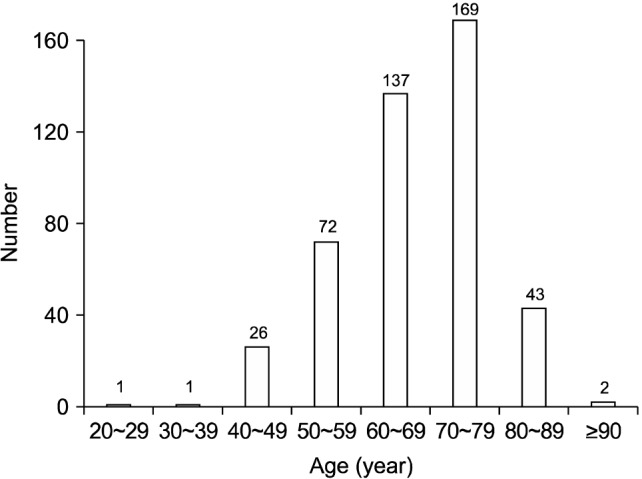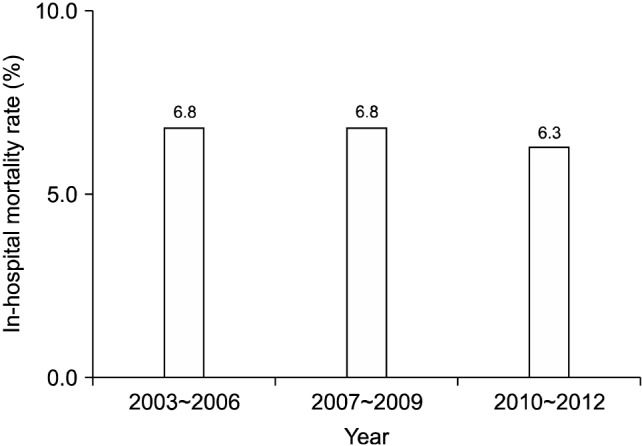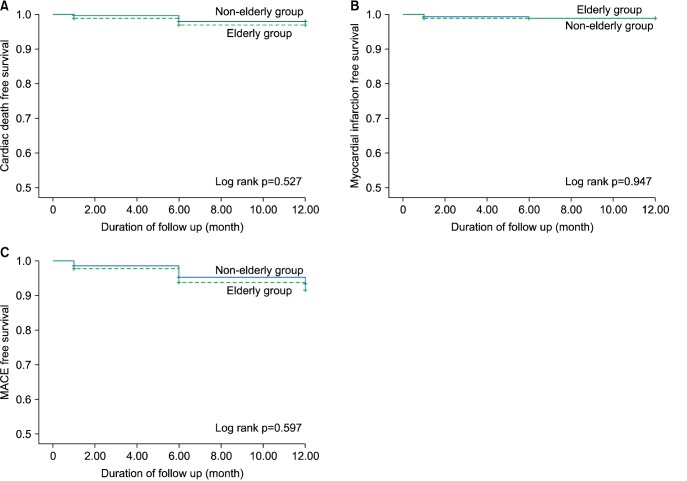Chonnam Med J.
2018 Jan;54(1):41-47. 10.4068/cmj.2018.54.1.41.
Clinical Outcomes of Elderly Patients with Non ST-Segment Elevation Myocardial Infarction Undergoing Coronary Artery Bypass Surgery
- Affiliations
-
- 1Department of Cardiology, Kwangju Christian Hospital, Gwangju, Korea.
- 2Department of Cardiology, Chonnam National University Hospital, Gwangju, Korea. myungho@chol.com
- 3Department of Cardiology, Yeungnam University Hospital, Daegu, Korea.
- 4Department of Cardiology, Kyung Hee University Hospital, Seoul, Korea.
- 5Department of Cardiology, Chungbuk National University Hospital, Cheongju, Korea.
- KMID: 2458584
- DOI: http://doi.org/10.4068/cmj.2018.54.1.41
Abstract
- The aim of this study is to investigate the clinical outcomes of the elderly patients with Non ST-segment elevation myocardial infarction (NSTEMI) undergoing coronary artery bypass surgery (CABG) compared to non-elderly patients. Patients with NSTEMI and undergoing CABG (n=451) who were registered in the Korea Acute Myocardial Infarction Registry between December 2003 and August 2012 were divided into two groups.; the non-elderly group ( < 75 years, n=327) and the elderly group (≥75 years, n=124). In-hospital mortality was higher in the elderly group (4.9% vs. 11.3%, p=0.015), but cardiac death, myocardial infarction, and major adverse cardiovascular events (MACE) including cardiac death, myocardial infarction, percutaneous revascularization, and redo-CABG after a one-year follow up were not different between the two groups. Predictors of in-hospital mortality in patients with NSTEMI undergoing CABG were left ventricular (LV) dysfunction (ejection fraction ≤40%) [hazard ratio (HR): 2.76, 95% confidence interval (CI): 1.16-6.57, p=0.022] and age (HR: 1.05, 95% CI: 1.01-1.10, p=0.047). So elderly NSTEMI patients should be considered for CABG if appropriate, but careful consideration for surgery is required, especially if the patients have severe LV systolic dysfunction.
Keyword
MeSH Terms
Figure
Reference
-
1. Amsterdam EA, Wenger NK, Brindis RG, Casey DE Jr, Ganiats TG, Holmes DR Jr, et al. 2014 AHA/ACC guideline for the management of patients with non-ST-elevation acute coronary syndromes: a report of the American College of Cardiology/American Heart Association Task Force on Practice Guidelines. Circulation. 2014; 130:e344–e426. PMID: 25249585.2. Hillis LD, Smith PK, Anderson JL, Bittl JA, Bridges CR, Byrne JG, et al. A report of the American College of Cardiology Foundation/American Heart Association Task Force on Practice Guidelines. Developed in collaboration with the American Association for Thoracic Surgery, Society of Cardiovascular Anesthesiologists, and Society of Thoracic Surgeons. J Am Coll Cardiol. 2011; 58:e123–e210. PMID: 22070836.3. Natarajan A, Samadian S, Clark S. Coronary artery bypass surgery in elderly people. Postgrad Med J. 2007; 83:154–158. PMID: 17344568.4. Sim DS, Jeong MH, Cho KH, Ahn Y, Kim YJ, Chae SC, et al. Effect of early statin treatment in patients with cardiogenic shock complicating acute myocardial infarction. Korean Circ J. 2013; 43:100–109. PMID: 23508129.5. Braunwald E, Antman EM, Beasley JW, Califf RM, Cheitlin MD, Hochman JS, et al. ACC/AHA guideline update for the management of patients with unstable angina and non-ST-segment elevation myocardial infarction--2002: summary article: a report of the American College of Cardiology/American Heart Association Task Force on Practice Guidelines (Committee on the Management of Patients With Unstable Angina). Circulation. 2002; 106:1893–1900. PMID: 12356647.6. Alexander KP, Newby LK, Cannon CP, Armstrong PW, Gibler WB, Rich MW, et al. Acute coronary care in the elderly, part I: Non-ST-segment-elevation acute coronary syndromes: a scientific statement for healthcare professionals from the American Heart Association Council on Clinical Cardiology: in collaboration with the Society of Geriatric Cardiology. Circulation. 2007; 115:2549–2569. PMID: 17502590.7. French JK, White HD. Clinical implications of the new definition of myocardial infarction. Heart. 2004; 90:99–106. PMID: 14676259.8. Newby LK, Jesse RL, Babb JD, Christenson RH, De Fer TM, Diamond GA, et al. ACCF 2012 expert consensus document on practical clinical considerations in the interpretation of troponin elevations: a report of the American College of Cardiology Foundation task force on Clinical Expert Consensus Documents. J Am Coll Cardiol. 2012; 60:2427–2463. PMID: 23154053.9. Quinones MA, Waggoner AD, Reduto LA, Nelson JG, Young JB, Winters WL Jr, et al. A new, simplified and accurate method for determining ejection fraction with two-dimensional echocardiography. Circulation. 1981; 64:744–753. PMID: 7273375.10. Levey AS, Stevens LA, Schmid CH, Zhang YL, Castro AF 3rd, Feldman HI, et al. A new equation to estimate glomerular filtration rate. Ann Intern Med. 2009; 150:604–612. PMID: 19414839.11. Ellis SG, Vandormael MG, Cowley MJ, DiSciascio G, Deligonul U, Topol EJ, et al. Multivessel Angioplasty Prognosis Study Group. Coronary morphologic and clinical determinants of procedural outcome with angioplasty for multivessel coronary disease. Implications for patient selection. Circulation. 1990; 82:1193–1202. PMID: 2401060.12. Ghanta RK, Shekar PS, McGurk S, Rosborough DM, Aranki SF. Nonelective cardiac surgery in the elderly: is it justified? J Thorac Cardiovasc Surg. 2010; 140:103–109. 109.e1PMID: 20005528.13. Bardakci H, Cheema FH, Topkara VK, Dang NC, Martens TP, Mercando ML, et al. Discharge to home rates are significantly lower for octogenarians undergoing coronary artery bypass graft surgery. Ann Thorac Surg. 2007; 83:483–489. PMID: 17257973.14. Parikh SV, de Lemos JA, Jessen ME, Brilakis ES, Ohman EM, Chen AY, et al. Timing of in-hospital coronary artery bypass graft surgery for non-ST-segment elevation myocardial infarction patients results from the National Cardiovascular Data Registry ACTION Registry-GWTG (Acute Coronary Treatment and Intervention Outcomes Network Registry-Get With The Guidelines). JACC Cardiovasc Interv. 2010; 3:419–427. PMID: 20398870.15. Krane M, Voss B, Hiebinger A, Deutsch MA, Wottke M, Hapfelmeier A, et al. Twenty years of cardiac surgery in patients aged 80 years and older: risks and benefits. Ann Thorac Surg. 2011; 91:506–513. PMID: 21256302.16. Peterson ED, Cowper PA, Jollis JG, Bebchuk JD, DeLong ER, Muhlbaier LH, et al. Outcomes of coronary artery bypass graft surgery in 24,461 patients aged 80 years or older. Circulation. 1995; 92(9 Suppl):II85–II91. PMID: 7586468.17. Ohira S, Doi K, Numata S, Yamazaki S, Yamamoto T, Fukuishi M, et al. Does age at operation influence the short- and long-term outcomes of off-pump coronary artery bypass grafting? Circ J. 2015; 79:2177–2185. PMID: 26227150.18. Conaway DG, House J, Bandt K, Hayden L, Borkon AM, Spertus JA. The elderly: health status benefits and recovery of function one year after coronary artery bypass surgery. J Am Coll Cardiol. 2003; 42:1421–1426. PMID: 14563586.19. Huber CH, Goeber V, Berdat P, Carrel T, Eckstein F. Benefits of cardiac surgery in octogenarians--a postoperative quality of life assessment. Eur J Cardiothorac Surg. 2007; 31:1099–1105. PMID: 17369044.20. Fortescue EB, Kahn K, Bates DW. Development and validation of a clinical prediction rule for major adverse outcomes in coronary bypass grafting. Am J Cardiol. 2001; 88:1251–1258. PMID: 11728352.21. Yau TM, Fedak PW, Weisel RD, Teng C, Ivanov J. Predictors of operative risk for coronary bypass operations in patients with left ventricular dysfunction. J Thorac Cardiovasc Surg. 1999; 118:1006–1013. PMID: 10595971.22. Aldea GS, Gaudiani JM, Shapira OM, Jacobs AK, Weinberg J, Cupples AL, et al. Effect of gender on postoperative outcomes and hospital stays after coronary artery bypass grafting. Ann Thorac Surg. 1999; 67:1097–1103. PMID: 10320257.23. O'Connor GT, Morton JR, Diehl MJ, Olmstead EM, Coffin LH, Levy DG, et al. The Northern New England Cardiovascular Disease Study Group. Differences between men and women in hospital mortality associated with coronary artery bypass graft surgery. Circulation. 1993; 88:2104–2110. PMID: 8222104.24. Brandrup-Wognsen G, Berggren H, Hartford M, Hjalmarson A, Karlsson T, Herlitz J. Female sex is associated with increased mortality and morbidity early, but not late, after coronary artery bypass grafting. Eur Heart J. 1996; 17:1426–1431. PMID: 8880029.25. O'Rourke DJ, Malenka DJ, Olmstead EM, Quinton HB, Sanders JH Jr, Lahey SJ, et al. Northern New England Cardiovascular Disease Study Group. Improved in-hospital mortality in women undergoing coronary artery bypass grafting. Ann Thorac Surg. 2001; 71:507–511. PMID: 11235698.26. Vaccarino V, Abramson JL, Veledar E, Weintraub WS. Sex differences in hospital mortality after coronary artery bypass surgery: evidence for a higher mortality in younger women. Circulation. 2002; 105:1176–1181. PMID: 11889010.27. Kim C, Redberg RF, Pavlic T, Eagle KA. A systematic review of gender differences in mortality after coronary artery bypass graft surgery and percutaneous coronary interventions. Clin Cardiol. 2007; 30:491–495. PMID: 17880013.
- Full Text Links
- Actions
-
Cited
- CITED
-
- Close
- Share
- Similar articles
-
- Differences in Clinical Outcomes Between Patients With ST-Elevation Versus Non-ST-Elevation Acute Myocardial Infarction in Korea
- Acute Myocardial Infarction by Right Coronary Artery Occlusion Presenting as Precordial ST Elevation on Electrocardiography
- Precordial ST-Segment Elevation in Acute Right Ventricular Myocardial Infarction
- Simultaneous Total Occlusion of Multiple Distal Coronary Arteries in Acute Myocardial Infarction
- ST segment




